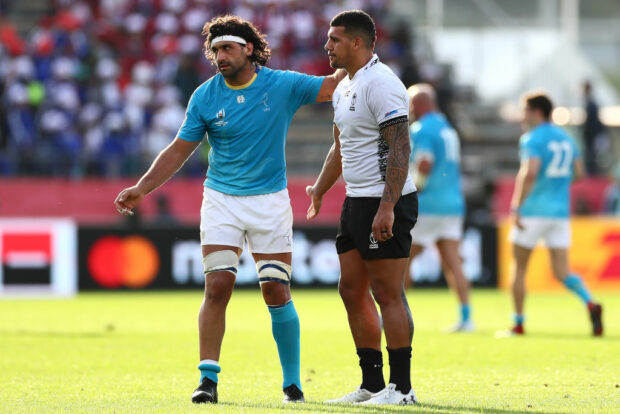
JAPAN have done it again, giving the 2019 World Cup much-needed lift-off with their brilliant 19-12 victory over Ireland, just as they did in the 2015 tournament by beating South Africa.
The Shizuoka Stadium, now ranks alongside Brighton as a venue where planet rugby shifted on its axis, with Japan doing the shifting both times.
The host nation rescued what in prospect had looked a fairly humdrum second Saturday of the tournament with their heroics against the Irish – and although there will be no green-shirted fans thanking them for it, the rest of the rugby world is buzzing at the thought of Japan making it through to the last eight.
This time there is also no wishful thinking involved in suggesting that, if Japan play as well as they did against Ireland, they could become the first Tier 2 side to make the big breakthrough to a World Cup semi-final.
This is because the ‘Brave Blossoms’ were that good. Match statistics can sometimes be misleading – but that is rarely the case when you are ahead in every area, as Japan were, not only making more metres than Ireland (471 to 318), but winning the arm wrestle for possession, tackle effectiveness, defenders beaten, carries made, as well as conceding fewer penalties (six to nine).
Heroes abounded in the Japanese ranks, and while they may be dependent on some South African and Antipodean ballast in their pack, the great news is that the majority of their stars last weekend were born in Japan.
I have no hesitation in saying that their human dynamo hooker Shota Horie – who also started in their 2015 win over the Springboks – is one of the best in the world, and that their blindside flanker, Kazuki Himeno, is a force of nature.
Inside-centre Ryko Nakamura also combined superbly with his strong, skilful Tongan-born partner at 13, Timothy Lafaele, with both having exceptional games.
It was Nakamura’s rifle shot miss-pass to Lafaele which gave him the space to put super-sub winger Kenki Fukuoka in for the try that gave Japan the lead on the hour.
What often happens when Tier 2 teams like Japan are on the brink of a giant-killing is that they lose their nerve, squandering points at crucial moments, rather than applying the thumbscrews.
The conversion that Japan fly-half Yu Tamura faced after Fukuoka’s try was a case in point, and despite his success with three first half penalties, many of the Japanese supporters in the crowd had their hands clasped together, as if in prayer, just before he kicked.
However, Tamura held his nerve to knock over the extras and extend Japan’s lead to 16-12, and when he repeated the trick with a long-range penalty eight minutes from time to give his side a seven-point cushion, the Irish knew that a last-hurrah draw had slipped beyond their reach.

Nor can another Brighton veteran be left out of the roll of honour because electrifying winger Kotaro Matsushima defended as if his life depended on it.
The same applied to Michael Leitch, the Kiwi-born Japanese-speaking captain, who is a true adopted son. Leach proved he remains the rising son of Japanese rugby, because, having captained them against South Africa four years ago, he was again inspirational here, coming off the bench just before the half-hour.
Japan were brave, and through their fast-paced cut-and-thrust rugby, they may become the driving force for the game to blossom in Japan, and from there into other parts of Asia.
Just how much this is a game in which emotion is like rocket-fuel for teams who can keep pumping from the tank, rather than letting an overflow flood the engine, was also demonstrated in midweek by Uruguay’s extraordinary 30-27 victory over Fiji.
Just as historically it has been very rare for a Tier 1 nation to lose to one from Tier 2, as happened to Ireland, the same applies to a top end Tier 2 nation losing to a Tier 3 minnow like Uruguay, a country with only 4,500 players.
Despite being outweighed by the Fijian pack by nearly a stone and a half per man (nine kg), Uruguay’s fitness – honed by Craig White, the former Lions and the Wasps strength and conditioning coach – gave them legs. That, combined with a superbly coordinated defensive system, and the indomitable tenacity and teamwork of a tightly-bonded group, carried the Uruguayans home. However, the reality is that the majority of matches between those in Tier 1 and Tiers 2/3 are still a procession of predictable mismatches – and there are many more of them in World Cups than is good for the competitive status of the tournament.
One solution that must be considered is revisiting the idea of holding a Tier 2/3 tournament – let’s call it a Silver World Cup – where the winners and the other three semi-finalists go through to join the 12 Tier 1 teams in the gold-standard World Cup.
This could be played the year before the main tournament in another host venue, or it could be played in the same host nation as the World Cup three weeks before the main event, with a four pools of three teams format in which the winners progress straight to the semi-finals.
That would mean a 16 team World Cup in a shorter time frame, and it should guarantee tournaments with a far higher quotient of highly competitive games. The World Cup should be revamped so that there are more Japans and Uruguays challenging the established pecking order.


British and Irish Lions
Maro Itoje named British and Irish Lions captain for tour of Australia

























You must be logged in to post a comment Login